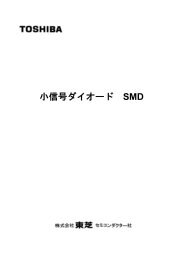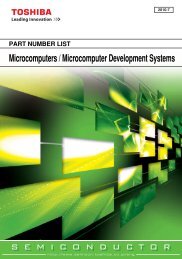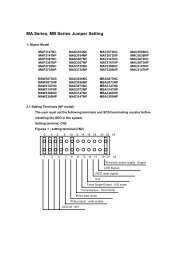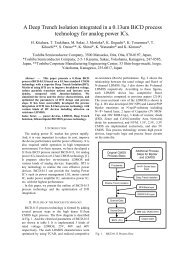High-Frequency Semiconductors Power Devices
High-Frequency Semiconductors Power Devices
High-Frequency Semiconductors Power Devices
Create successful ePaper yourself
Turn your PDF publications into a flip-book with our unique Google optimized e-Paper software.
[ 5 ] Device Features in Detail<br />
Figure 1.2 shows the frequency locus of α. When actually measuring α, the difference between<br />
theoretical and measured values increases as the frequency approaches f α . This is because the<br />
Early’s equivalent circuit is based on an first approximation of physical phenomena.<br />
To correct it, Thomas-Moll introduced excess phase m and offered the equation.<br />
α ⎛ ⎞<br />
α = 0 f<br />
exp⎜<br />
⎟<br />
− jm<br />
..........................................................................(9)<br />
f<br />
+ ⎝ f<br />
1 j<br />
α ⎠<br />
fα<br />
m<br />
π<br />
4<br />
R e (α)<br />
0.5<br />
α<br />
α = 0<br />
f<br />
1+<br />
j<br />
fα<br />
1.0<br />
−j 0.5<br />
α<br />
α =<br />
0<br />
f<br />
1+<br />
j<br />
fα<br />
⎛ f<br />
exp⎜<br />
− jm<br />
⎝ fα<br />
⎟ ⎞<br />
⎠<br />
Im (α)<br />
f α<br />
Figure 1.2 <strong>Frequency</strong> Locus of α<br />
The above equation agrees well with measured values in frequencies less than f α .<br />
r bb’: Base diffusion resistance<br />
This is resistance from the center of the base area to the external base terminal, which<br />
actually contributes to transistor action. It is determined according to the shape and dimensions<br />
of the transistor, and the base specific resistance.<br />
rbb’ ∼<br />
q B 8 πW<br />
.......................................................................................(10)<br />
− ( Ω)<br />
where,<br />
qB: Specific resistance of base area (Ω・m)<br />
DC Current gain (β) at the common emitter is represented as follows:<br />
β =<br />
α0<br />
1<br />
β<br />
= 0<br />
1 − α0<br />
1 + jωCb'erb'e<br />
1 + jωCb'erb'e<br />
The β-interrupting frequency f β is defined as the frequency at which the absolute value of β<br />
becomes β 0 2 . f β is represented similarly to f α , as:<br />
1<br />
fβ<br />
=<br />
2 πC b' erb'e<br />
therefore,<br />
β<br />
β = 0 ...............................................................................................(11)<br />
f<br />
1 + j<br />
fβ<br />
42









